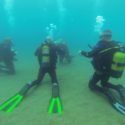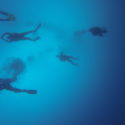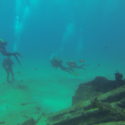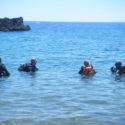Over 5th – 12th September 2014, a team 9 of divers, consisting of 7 members of Army Training Unit (North East), a member of 170 Royal Engineers and our Sub-Aqua Diving Supervisor, a Royal Signals WO who is currently working at the Royal Artillery Barracks, Larkhill, undertook an adventure training expedition in Lanzarote. The aim originally was to increase the experience of newly qualified BSAC (British Sub-Aqua Club) Ocean Divers (OD) and to conduct deeper and more varied dives to progress the qualified divers towards attaining their next diving qualification. However, due to unforeseen circumstances the 2 novice divers needed to use their first few dives in Lanzarote as their qualification dives for the OD qualification. This did then enable the other members of the group to brush up on their skills. Our 2 newly qualified ODs and another OD who gained his qualification last year worked really hard and through sheer determination were able to also gain their BSAC Sport Diver qualification by the end of the expedition.
The expedition was based in Puerto del Carmen in the south east part of the Island, but Lanzarote is a reasonable size and it is possible to dive off any part of the island, depending upon the prevailing wind and weather. The weather proved to be perfect, with hot sunny days and calm placid sea conditions; this meant that we had the pick of the Island’s dive sites, though there were some interesting currents below the surface.
We dived mainly off the shores of Lanzarote, but also conducted a couple of boat dives along the coast. Initially we dived in the Puerto del Carmen Bay area, a shallow area which allowed the novice Ocean Divers to complete their qualifying dives and then once newly qualified they were able to build up their experience and confidence so that the dives could become progressively deeper and more challenging.
The night dive in Puerto del Carmen Bay proved fascinating, particularly for those who had never experienced it before as a whole new world opened up to them compared with day time diving. Angel sharks, an octopus, hoards of shrimp and an incident with a sea urchin made for enthusiastic story telling later in the evening.
A number of wreck dives were conducted over the week, with one fascinating dive on the Temple Hall. The majority of the Temple Hall wreck was above the waterline, where it had run aground. The main section of the wreck was intact, with the bow pointing to shore and the stern badly damaged and scattered over the seabed, a perfect place for large rays, and other sealife to hide themselves.
The “off-gas” day was spent by some visiting the Timanfaya National Park, with its active volcano, lava fields, camel rides, Mars-like landscape and extreme heat proving fascinating.
The Assistance provided by the Ulysses Trust is greatly appreciated by all the members of the expedition, and enables the cost of the expedition to become more affordable to more personnel. Therefore I would like to thank the Trust on behalf of all our expedition members.




